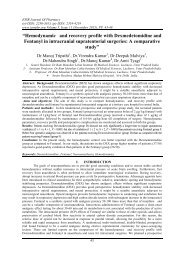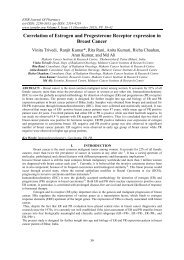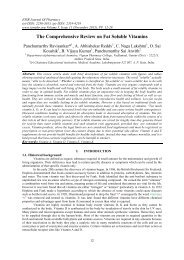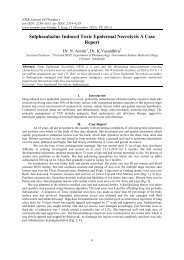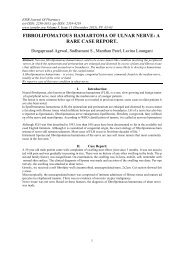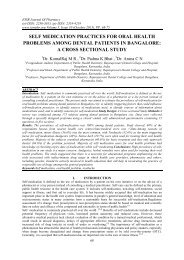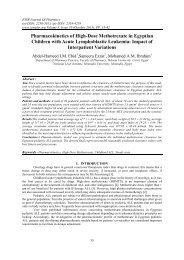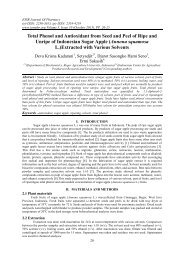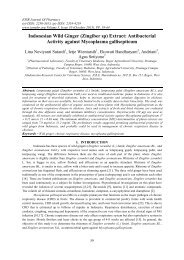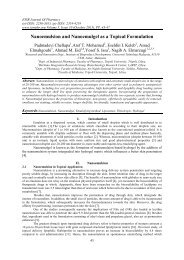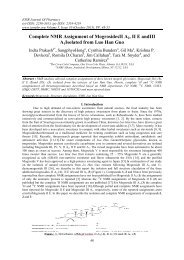Clinical manifestations, diagnosis,and treatment of Melioidosis
You also want an ePaper? Increase the reach of your titles
YUMPU automatically turns print PDFs into web optimized ePapers that Google loves.
<strong>Clinical</strong> <strong>manifestations</strong>, <strong>diagnosis</strong>…<br />
[17]. Dance DA,Wuthiekanun V,Naigwit R,et al.,Identification <strong>of</strong> Pseudomonas pseudomallei in clinical practice:Use <strong>of</strong> simple<br />
screening test <strong>and</strong> API 20NE.J ClinPathol.1989;42:645-48.<br />
[18]. Phetsouvanh R,Phongmany S,Soukloun D,et al.Causes <strong>of</strong> community- acquired bacteremia <strong>and</strong> pattern <strong>of</strong> antimicrobial<br />
resistance in Vientiane,Laos.Am J Trop MedHyg.2006;75:978-85<br />
[19]. Dance DA. <strong>Melioidosis</strong>: The tip <strong>of</strong> the iceberg? Clin MicrobiolRev. 1991;4:52-60.<br />
[20]. White NJ. <strong>Melioidosis</strong>. Lancet. 2003;361:1715-1722.<br />
[21]. Cheng AC, Currie BJ. <strong>Melioidosis</strong>: epidemiology, pathophysiology, <strong>and</strong> management. Clin Microbiol Rev. 2005;18:383-416.<br />
[22]. Punyagupta S. <strong>Melioidosis</strong>: Review <strong>of</strong> 686 cases <strong>and</strong> presentation <strong>of</strong> a new clinical classification. In: Punyagupta Sirisanthana<br />
T, Stapatayavong B, eds. <strong>Melioidosis</strong>. Bangkok: Bangkok Medical; 1989:217-229.<br />
[23]. Chaowagul W, White NJ, Dance DA, et al. <strong>Melioidosis</strong>: A major cause <strong>of</strong> community-acquired septicemia in northeastern<br />
Thail<strong>and</strong>.J Infect Dis. 1989;159:890-899.<br />
[24]. Vuddhakul V, Tharavichitkul P, Na-Ngam N, et al. Epidemiology <strong>of</strong> Burkholderia pseudomallei in Thail<strong>and</strong>. Am J Trop<br />
MedHyg. 1999;60:458-461.<br />
[25]. Leelarasamee A. <strong>Melioidosis</strong> in Southeast Asia. Acta Trop.2000; 74:129-132.<br />
[26]. Puthucheary SD, Parasakthi N, Lee MK. Septicaemic melioidosis: A review <strong>of</strong> 50 cases from Malaysia. Trans R Soc Trop<br />
MedHyg. 1992;86:683-685.<br />
[27]. Yap EH, Chan YC, Goh KT, et al. Sudden unexplained death syndrome—a new manifestation in melioidosis? EpidemiolInfect.<br />
1991;107:577-584.<br />
[28]. Liu Y, Loh JP, Aw LT, et al. Rapid molecular typing <strong>of</strong> Burkholderia pseudomallei, isolated in an outbreak <strong>of</strong> melioidosis in<br />
Singaporein 2004, based on variable-number t<strong>and</strong>em repeatsTrans R Soc Trop Med Hyg. 2006;100:687-692.<br />
[29]. Dance DA. <strong>Melioidosis</strong> as an emerging global problem. Acta Trop. 2000;74:115-119.<br />
[30]. Lee N, Wu JL, Lee CH, et al. Pseudomonas pseudomallei infection from drowning: The first reported case in Taiwan. J Clin<br />
Microbiol. 1985;22:352-354.<br />
[31]. Hsueh PR, Teng LJ, Lee LN, et al. <strong>Melioidosis</strong>: An emerginginfection in Taiwan? Emerg Infect Dis. 2001;7:428-433.<br />
[32]. Parry CM, Wuthiekanun V, Hoa NT, et al. <strong>Melioidosis</strong> in Southern Vietnam: <strong>Clinical</strong> surveillance <strong>and</strong> environmental<br />
sampling.Clin Infect Dis. 1999;29:1323-1326.<br />
[33]. Phetsouvanh R, Phongmany S, Soukaloun D, et al. Causes <strong>of</strong> community-acquired bacteremia <strong>and</strong> patterns <strong>of</strong> antimicrobial<br />
resistance in Vientiane, Laos. Am J Trop Med Hyg. 2006;75:978- 985.<br />
[34]. Wuthiekanun V, Pheaktra N, Putchhat H, et al. Burkholderia pseudomallei antibodies in children, Cambodia. Emerg<br />
InfectDis. 2008;14:301-303.<br />
[35]. Cherian T, Raghupathy P, John TJ. Plague in India. Lancet. 1995;345:258-259.<br />
[36]. Dance DA, S<strong>and</strong>ers D, Pitt TL, et al. Burkholderia pseudomallei<strong>and</strong> Indian plague-like illness. Lancet. 1995;346:904-905.<br />
[37]. Athan E, Allworth AM, Engler C, et al. <strong>Melioidosis</strong> in tsunami survivors. Emerg Infect Dis. 2005;11:1638-1639.<br />
[38]. Le Hello S, Currie BJ, Godoy D, et al. <strong>Melioidosis</strong> in New Caledonia. Emerg Infect Dis. 2005;11:1607-1609.<br />
[39]. Inglis TJ, Rolim DB, Sousa Ade Q. <strong>Melioidosis</strong> in the Americas. Am J Trop Med Hyg. 2006;75:947-954.<br />
[40]. Borgherini GP, Poubeau F, Paganin S, et al. <strong>Melioidosis</strong>: an imported case from Madagascar. J Travel Med. 2006;13:318-320.<br />
[41]. Curries BJ.Burkholderia pseudomallei <strong>and</strong> Burkholderia mallei:<strong>Melioidosis</strong> <strong>and</strong> Gl<strong>and</strong>ers.In:M<strong>and</strong>el Douglas <strong>and</strong> Burnnett’s<br />
Principles <strong>and</strong> Practice <strong>of</strong> Infectious Diseases, 7 th Ed.M<strong>and</strong>ell GLBennett JE,Dolin R(editors).Churchill Livingstone Elsevier,<br />
2010.<br />
[42]. Currie BJ, Fisher DA, Howard DM, et al. The epidemiology <strong>of</strong> melioidosis in Australia <strong>and</strong> Papua New Guinea. Acta<br />
Trop.2000;74:121-127.<br />
[43]. Currie B, Smith Vaughan H, Golledge C, et al. Pseudomonas pseudomallei isolates collected over 25 years from a nontropicalendemic<br />
focus show clonality on the basis <strong>of</strong> ribotyping. Epidemiol Infect. 1994;113:307-312.44.<br />
[44]. Wuthiekanun V, Chierakul W, Langa S, et al. Development <strong>of</strong>antibodies to Burkholderia pseudomallei during childhood<br />
inmelioidosis-endemic northeast Thail<strong>and</strong>. Am J Trop Med Hyg.2006;74:1074-1075.<br />
[45]. Suputtamongkol Y, Hall AJ, Dance DA, et al. The epidemiology <strong>of</strong> melioidosis in Ubon Ratchatani, northeast Thail<strong>and</strong>. Int J<br />
Epidemiol. 1994;23:1082-1090.<br />
[46]. Ulett GC, Currie BJ, Clair TW, et al. Burkholderia pseudomallei virulence: Definition, stability <strong>and</strong> association with<br />
clonality.Microbes Infect. 2001;3:621-631.<br />
[47]. Currie BJ, Mayo M, Anstey NM, et al. A cluster <strong>of</strong> melioidosis cases from an endemic region is clonal <strong>and</strong> is linked to the water<br />
supply using molecular typing <strong>of</strong> Burkholderia pseudomallei isolates. Am J Trop Med Hyg. 2001;65:177-179.<br />
[48]. Holden MT, Titball RW, Peacock SJ, et al. Genomic plasticity <strong>of</strong> the causative agent <strong>of</strong> melioidosis, Burkholderia pseudomallei.<br />
Proc Natl Acad Sci U S A. 2004;101:14240-45.<br />
[49]. Tuanyok A, Auerbach RK, Brettin TS, et al. A horizontal gene transfer event defines two distinct groups within<br />
Burkholderiapseudomallei that have dissimilar geographic distributions. JBacteriol. 2007;189:9044-9049.<br />
[50]. Egan AM, Gordon DL. Burkholderia pseudomallei activates complement <strong>and</strong> is ingested but not killed by polymorphonuclear<br />
leukocytes. Infect Immun. 1996;64:4952-59.<br />
[51]. Brett PJ, Woods DE. Pathogenesis <strong>of</strong> <strong>and</strong> immunity to melioidosis. Acta Trop. 2000;74:201-210.<br />
[52]. DeShazer D, Brett PJ, Woods DE. The type II O-antigenic polysaccharidemoiety <strong>of</strong> Burkholderia pseudomallei<br />
lipopolysaccharide is required for serum resistance <strong>and</strong> virulence. MolMicrobiol. 1998;30:1081-1100.<br />
[53]. Reckseidler SL, DeShazer D, Sokol PA, et al. Detection <strong>of</strong> bacterial virulence genes by subtractive hybridization: identification<br />
<strong>of</strong> capsular polysaccharide <strong>of</strong> Burkholderia pseudomallei as amajor virulence determinant. Infect Immun. 2001;69:34-44.<br />
[54]. Woods DE. The use <strong>of</strong> animal infection models to study the pathogenesis <strong>of</strong> melioidosis <strong>and</strong> gl<strong>and</strong>ers. Trends Microbiol. 2002;<br />
11:483-484.<br />
[55]. DeShazer D, Waag DM, Fritz DL, et al. Identification <strong>of</strong> a Burkholderia mallei polysaccharide gene cluster by<br />
subtractivehybridization <strong>and</strong> demonstration that the encoded capsule is anessential virulence determinant. Microb Pathog.<br />
2001;30:253 269.<br />
[56]. Winstanley C, Hart CA. Presence <strong>of</strong> type III secretion genes in Burkholderia pseudomallei correlates with Ara − phenotypes. JClin<br />
Microbiol. 2000;38:883-885.<br />
[57]. Stevens MP, Wood MW, Taylor LA, et al. An Inv/Mxi-Spa-like type III protein secretion system in Burkholderia pseudomallei<br />
modulates intracellular behaviour <strong>of</strong> the pathogen. Mol Microbiol. 2002;46:649-659.<br />
[58]. Wiersinga WJ, van der Poll T, White NJ, et al. <strong>Melioidosis</strong>: Insights into the pathogenicity <strong>of</strong> Burkholderia pseudomallei.<br />
NatRev Microbiol. 2006;4:272-282.<br />
18




